check engine ACURA RL KA9 1996 Service Owner's Manual
[x] Cancel search | Manufacturer: ACURA, Model Year: 1996, Model line: RL KA9, Model: ACURA RL KA9 1996Pages: 1954, PDF Size: 61.44 MB
Page 466 of 1954
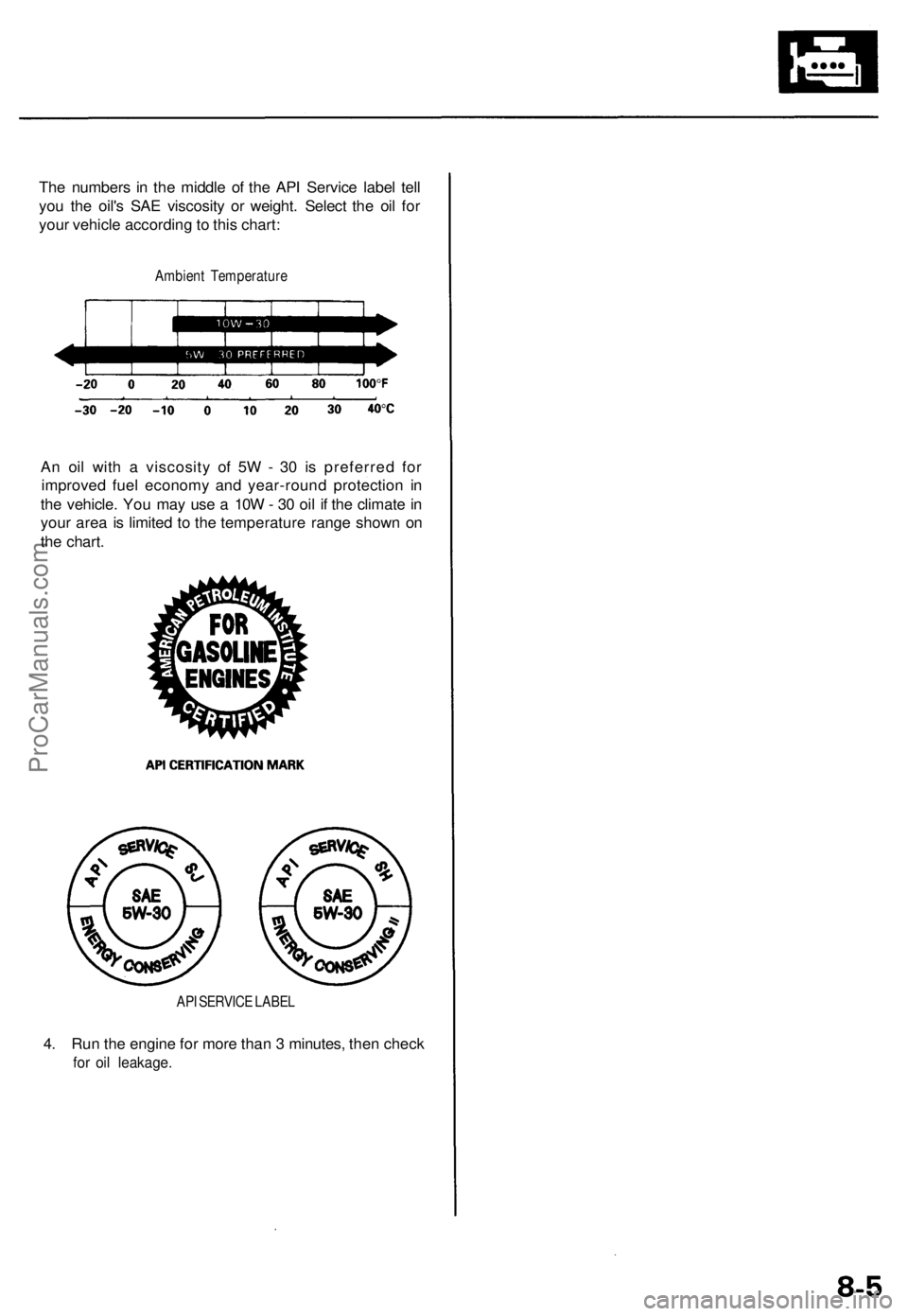
The numbers in the middle of the API Service label tell
you the oil's SAE viscosity or weight. Select the oil for
your vehicle according to this chart:
Ambient Temperature
An oil with a viscosity of 5W - 30 is preferred for
improved fuel economy and year-round protection in
the vehicle. You may use a 10W - 30 oil if the climate in
your area is limited to the temperature range shown on
the chart.
API SERVICE LABEL
4. Run the engine for more than 3 minutes, then check
for oil leakage.ProCarManuals.com
Page 472 of 1954
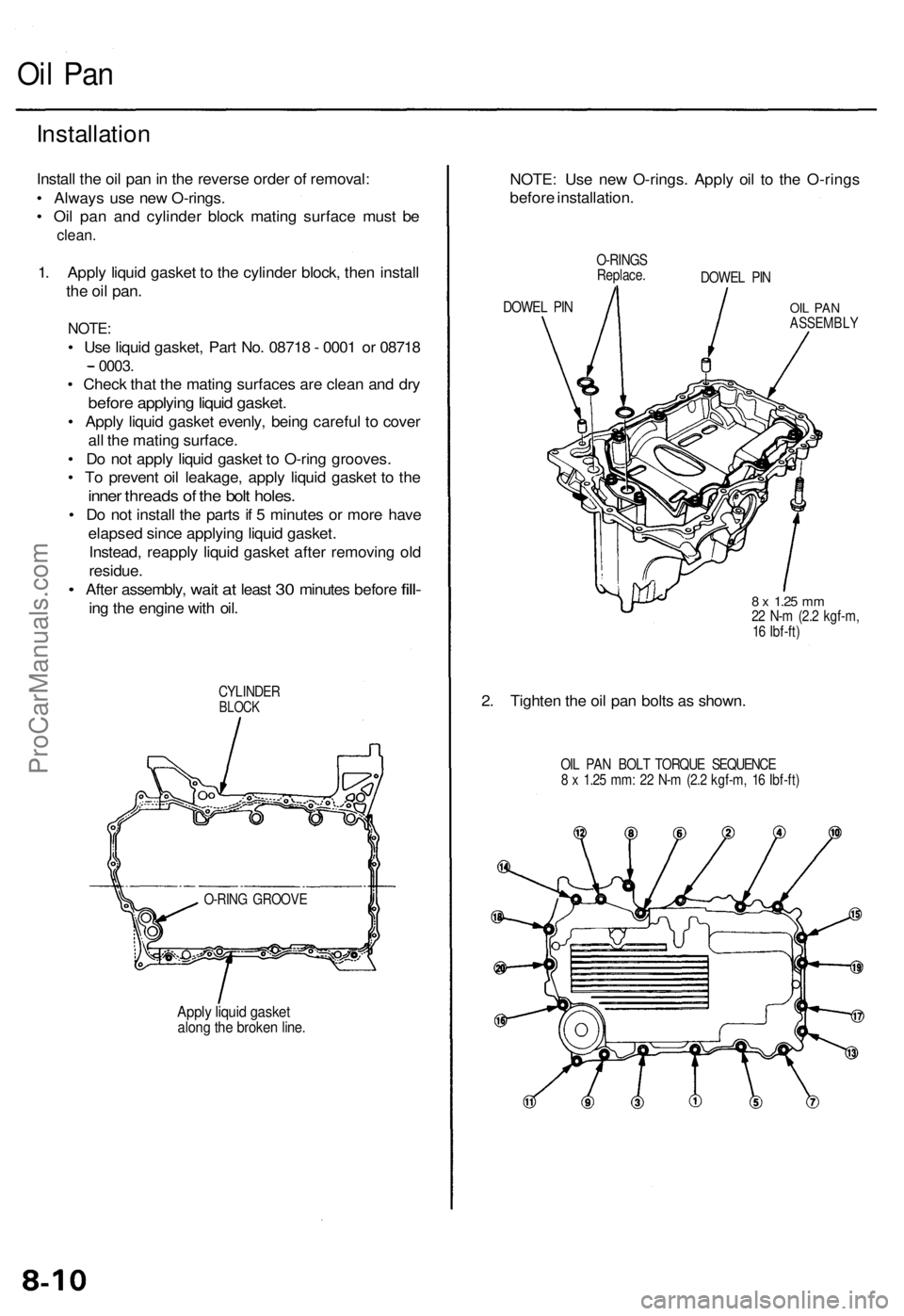
Oil Pan
Installation
Install the oil pan in the reverse order of removal:
• Always use new O-rings.
• Oil pan and cylinder block mating surface must be
clean.
1. Apply liquid gasket to the cylinder block, then install
the oil
pan.
NOTE:
• Use liquid gasket, Part No. 08718 - 0001 or 08718
0003.
• Check that the mating surfaces are clean and dry
before applying liquid gasket.
• Apply liquid gasket evenly, being careful to cover
all the mating surface.
• Do not apply liquid gasket to O-ring grooves.
• To prevent oil leakage, apply liquid gasket to the
inner threads of the bolt holes.
• Do not install the parts if 5 minutes or more have
elapsed since applying liquid gasket.
Instead, reapply liquid gasket after removing old
residue.
•
After assembly,
wait
at
least
30
minutes before
fill-
ing the engine with oil.
CYLINDER
BLOCK
O-RING GROOVE
Apply liquid gasket
along the broken line.
NOTE: Use new O-rings. Apply oil to the O-rings
before installation.
DOWEL PIN
O-RINGS
Replace.
DOWEL PIN
OIL PAN
ASSEMBLY
8 x
1.25
mm
22 N-m (2.2 kgf-m,
16 Ibf-ft)
2. Tighten the oil pan bolts as shown.
OIL PAN BOLT TORQUE SEQUENCE
8 x 1.25 mm: 22 N-m (2.2 kgf-m, 16 Ibf-ft)ProCarManuals.com
Page 487 of 1954
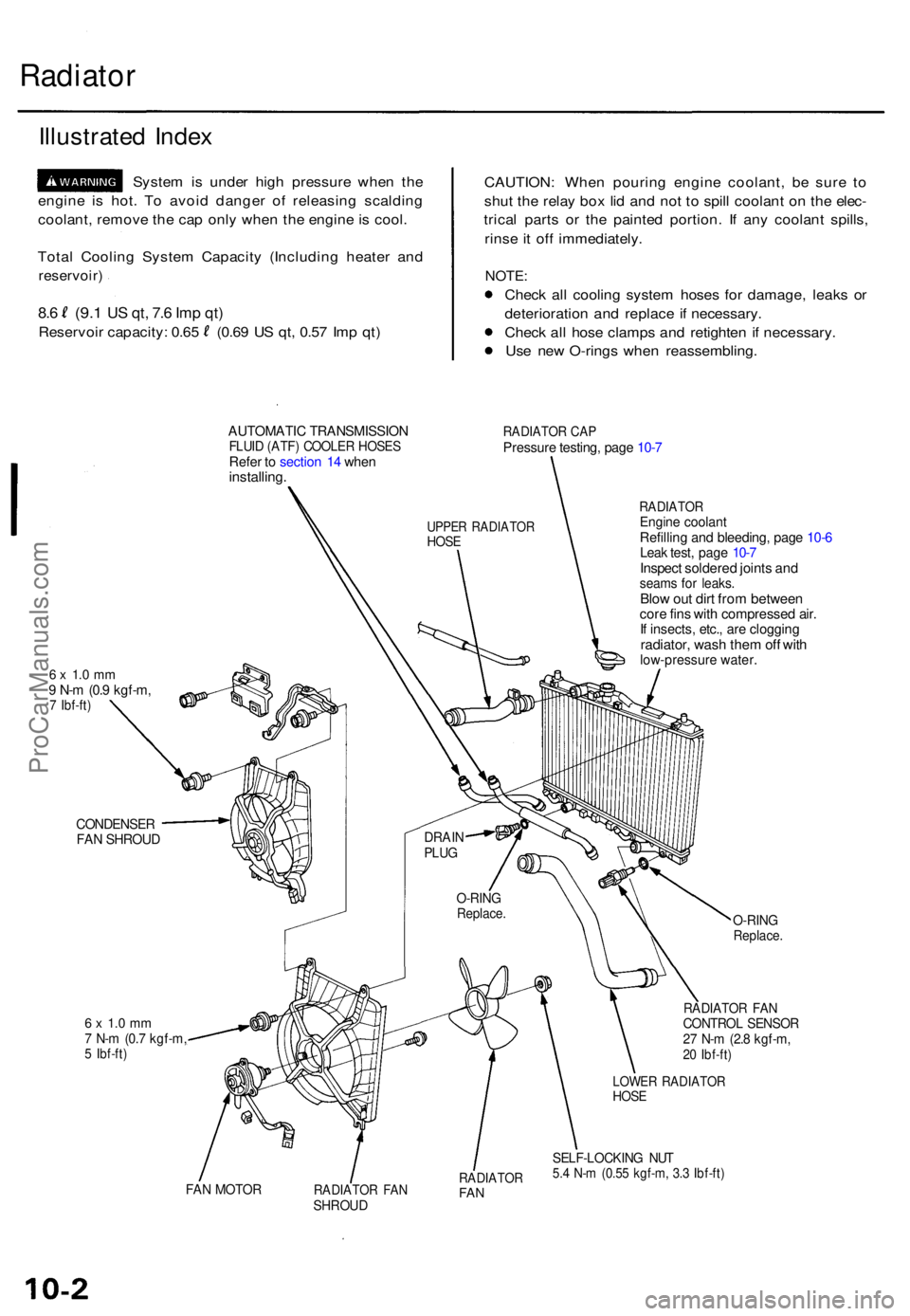
Radiator
Illustrate d Inde x
Syste m is unde r hig h pressur e whe n th e
engin e i s hot . T o avoi d dange r o f releasin g scaldin g
coolant , remov e th e ca p onl y whe n th e engin e is cool .
Tota l Coolin g Syste m Capacit y (Includin g heate r an d
reservoir )
8.6 (9. 1 US qt , 7. 6 Im p qt )
Reservoi r capacity : 0.6 5 (0.6 9 U S qt , 0.5 7 Im p qt ) CAUTION
: Whe n pourin g engin e coolant , b e sur e t o
shu t th e rela y bo x li d an d no t t o spil l coolan t o n th e elec -
trica l part s o r th e painte d portion . I f an y coolan t spills ,
rins e it of f immediately .
NOTE:
Check al l coolin g syste m hose s fo r damage , leak s o r
deterioratio n an d replac e if necessary .
Chec k al l hos e clamp s an d retighte n i f necessary .
Us e ne w O-ring s whe n reassembling .
AUTOMATIC TRANSMISSIO NFLUID (ATF ) COOLE R HOSE SRefer t o sectio n 1 4 whe ninstalling .
RADIATO R CA PPressur e testing , pag e 10-7
6 x 1. 0 m m9 N- m (0. 9 kgf-m ,7 Ibf-ft )
RADIATO REngine coolan tRefilling an d bleeding , pag e 10-6Lea k test , pag e 10-7Inspec t soldere d joint s an dseam s fo r leaks .Blow ou t dir t fro m betwee ncore fin s wit h compresse d air .If insects , etc. , ar e cloggin gradiator, was h the m of f wit hlow-pressur e water .
CONDENSE RFAN SHROU D
6 x 1. 0 m m7 N- m (0. 7 kgf-m ,5 Ibf-ft )
O-RIN GReplace .
RADIATO R FA NCONTRO L SENSO R27 N- m (2. 8 kgf-m ,20 Ibf-ft )
FAN MOTO RRADIATO R FA NSHROU D
RADIATO RFAN
LOWE R RADIATO RHOSE
SELF-LOCKIN G NU T5.4 N- m (0.5 5 kgf-m , 3. 3 Ibf-ft )
O-RIN GReplace .
DRAINPLUG
UPPE R RADIATO RHOSE
ProCarManuals.com
Page 492 of 1954
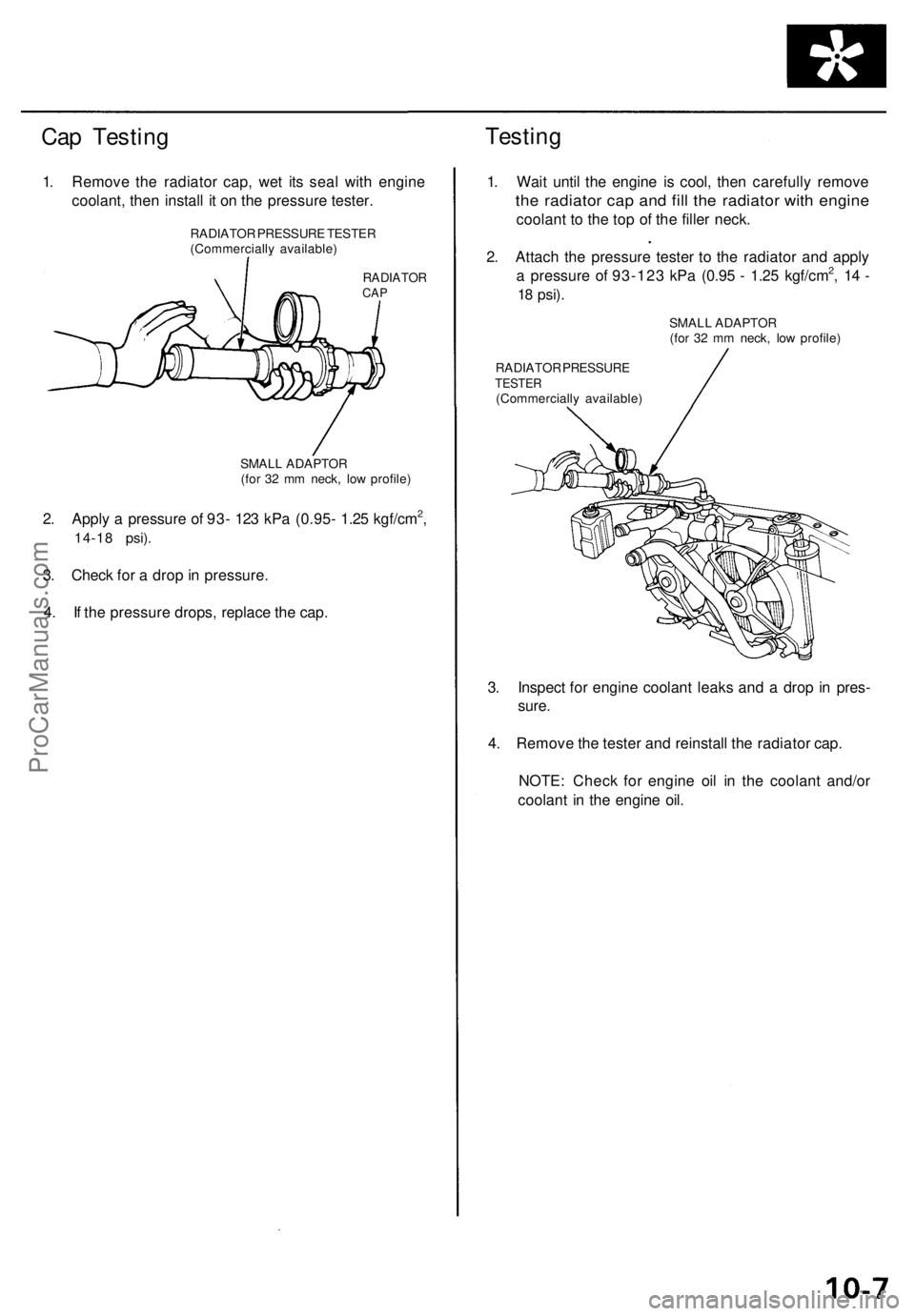
Cap Testing
Testing
1. Remove the radiator cap, wet its seal with engine
coolant, then install it on the pressure tester.
RADIATOR
CAP
2. Apply a pressure of 93- 123 kPa (0.95- 1.25 kgf/cm2,
14-18 psi).
3. Check for a drop in pressure.
4. If the pressure drops, replace the cap.
1. Wait until the engine is cool, then carefully remove
the radiator cap and fill the radiator with engine
coolant to the top of the filler neck.
2. Attach the pressure tester to the radiator and apply
a pressure of 93-123 kPa (0.95 - 1.25 kgf/cm2, 14 -
18
psi).
RADIATOR PRESSURE
TESTER
(Commercially available)
3. Inspect for engine coolant leaks and a drop in pres-
sure.
4. Remove the tester and reinstall the radiator cap.
NOTE: Check for engine oil in the coolant and/or
coolant in the engine oil.
RADIATOR PRESSURE TESTER
(Commercially available)
SMALL ADAPTOR
(for 32 mm neck, low profile)
SMALL ADAPTOR
(for 32 mm neck, low profile)ProCarManuals.com
Page 512 of 1954
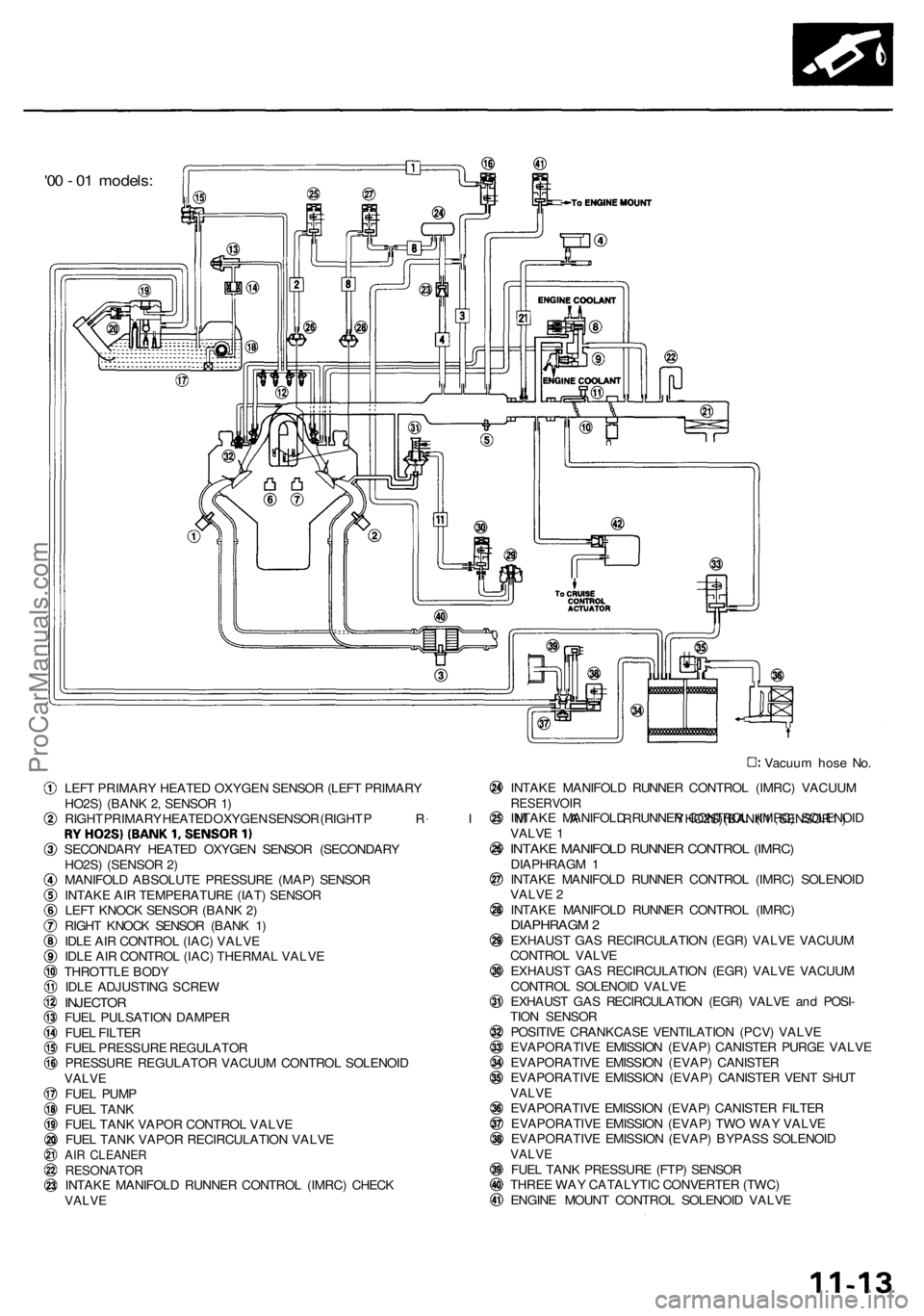
'00 - 01 models:
Vacuum hose No.
LEFT PRIMARY HEATED OXYGEN SENSOR (LEFT PRIMARY
HO2S) (BANK 2, SENSOR 1)
RIGHT PRIMARY HEATED OXYGEN SENSOR (RIGHT
PRIMARY
HO2S) (BANK
1,
SENSOR
1)
SECONDARY HEATED OXYGEN SENSOR (SECONDARY
HO2S) (SENSOR 2)
MANIFOLD ABSOLUTE PRESSURE (MAP) SENSOR
INTAKE AIR TEMPERATURE (IAT) SENSOR
LEFT KNOCK SENSOR (BANK 2)
RIGHT KNOCK SENSOR (BANK 1)
IDLE AIR CONTROL (IAC) VALVE
IDLE AIR CONTROL (IAC) THERMAL VALVE
THROTTLE BODY
IDLE ADJUSTING SCREW
INJECTOR
FUEL PULSATION DAMPER
FUEL FILTER
FUEL PRESSURE REGULATOR
PRESSURE REGULATOR VACUUM CONTROL SOLENOID
VALVE
FUEL PUMP
FUEL TANK
FUEL TANK VAPOR CONTROL VALVE
FUEL TANK VAPOR RECIRCULATION VALVE
AIR CLEANER
RESONATOR
INTAKE MANIFOLD RUNNER CONTROL (IMRC) CHECK
VALVE
INTAKE MANIFOLD RUNNER CONTROL (IMRC) VACUUM
RESERVOIR
INTAKE MANIFOLD RUNNER CONTROL (IMRC) SOLENOID
VALVE 1
INTAKE MANIFOLD RUNNER CONTROL (IMRC)
DIAPHRAGM 1
INTAKE MANIFOLD RUNNER CONTROL (IMRC) SOLENOID
VALVE 2
INTAKE MANIFOLD RUNNER CONTROL (IMRC)
DIAPHRAGM 2
EXHAUST GAS RECIRCULATION (EGR) VALVE VACUUM
CONTROL VALVE
EXHAUST GAS RECIRCULATION (EGR) VALVE VACUUM
CONTROL SOLENOID VALVE
EXHAUST GAS RECIRCULATION (EGR) VALVE and POSI-
TION SENSOR
POSITIVE CRANKCASE VENTILATION (PCV) VALVE
EVAPORATIVE EMISSION (EVAP) CANISTER PURGE VALVE
EVAPORATIVE EMISSION (EVAP) CANISTER
EVAPORATIVE EMISSION (EVAP) CANISTER VENT SHUT
VALVE
EVAPORATIVE EMISSION (EVAP) CANISTER FILTER
EVAPORATIVE EMISSION (EVAP) TWO WAY VALVE
EVAPORATIVE EMISSION (EVAP) BYPASS SOLENOID
VALVE
FUEL TANK PRESSURE (FTP) SENSOR
THREE WAY CATALYTIC CONVERTER (TWC)
ENGINE MOUNT CONTROL SOLENOID VALVEProCarManuals.com
Page 541 of 1954
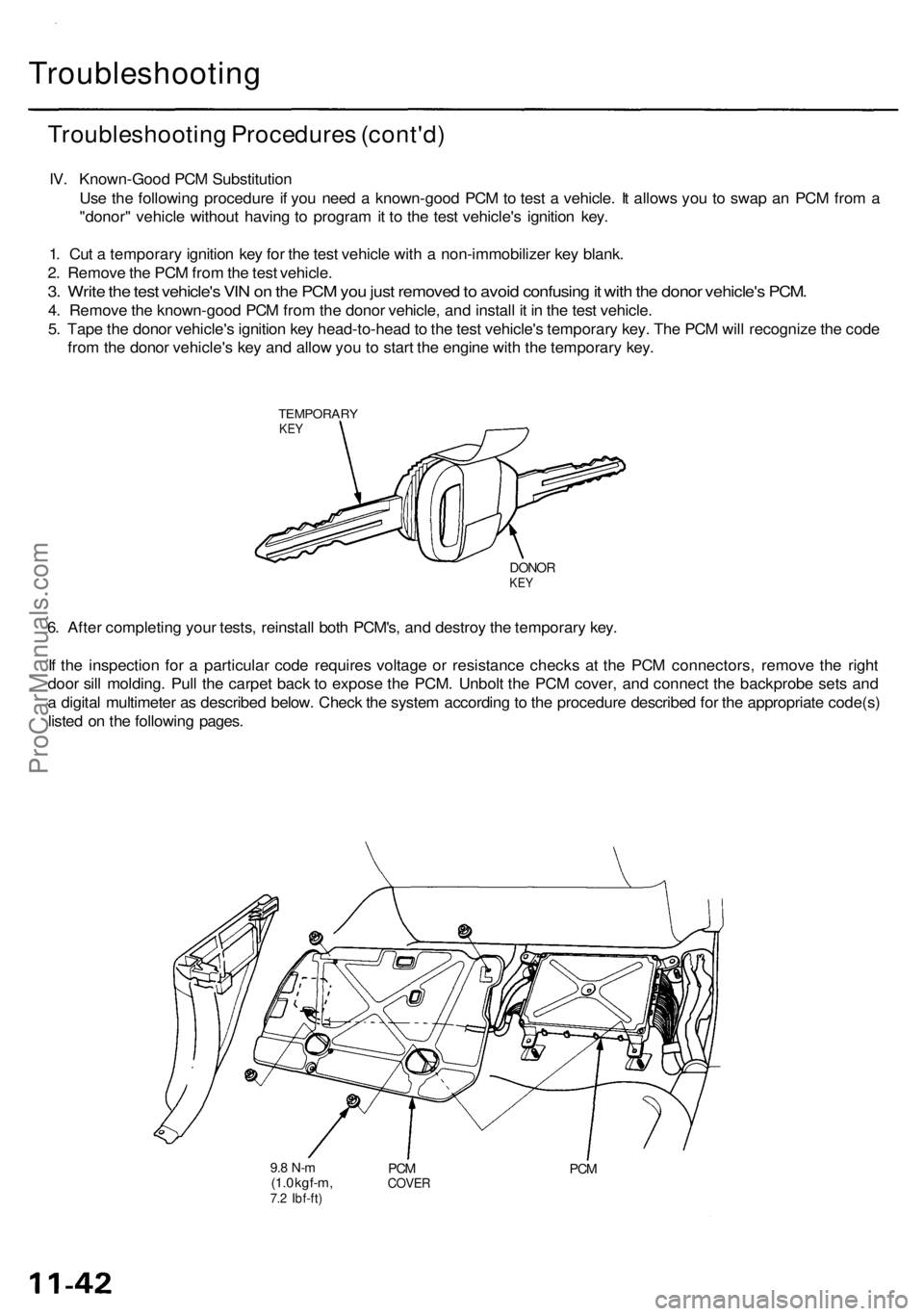
PCM
PCM
COVER
9.8 N-m
(1.0 kgf-m,
7.2 Ibf-ft)
6. After completing your tests, reinstall both PCM's, and destroy the temporary key.
If the inspection for a particular code requires voltage or resistance checks at the PCM connectors, remove the right
door sill molding. Pull the carpet back to expose the PCM. Unbolt the PCM cover, and connect the backprobe sets and
a digital multimeter as described below. Check the system according to the procedure described for the appropriate code(s)
listed on the following pages.
DONOR
KEY
TEMPORARY
KEY
Troubleshooting
Troubleshooting Procedures (cont'd)
IV. Known-Good PCM Substitution
Use the following procedure if you need a known-good PCM to test a vehicle. It allows you to swap an PCM from a
"donor" vehicle without having to program it to the test vehicle's ignition key.
1. Cut a temporary ignition key for the test vehicle with a non-immobilizer key blank.
2. Remove the PCM from the test vehicle.
3. Write the test vehicle's VIN on the PCM you just removed to avoid confusing it with the donor vehicle's PCM.
4. Remove the known-good PCM from the donor vehicle, and install it in the test vehicle.
5. Tape the donor vehicle's ignition key head-to-head to the test vehicle's temporary key. The PCM will recognize the code
from the donor vehicle's key and allow you to start the engine with the temporary key.ProCarManuals.com
Page 560 of 1954
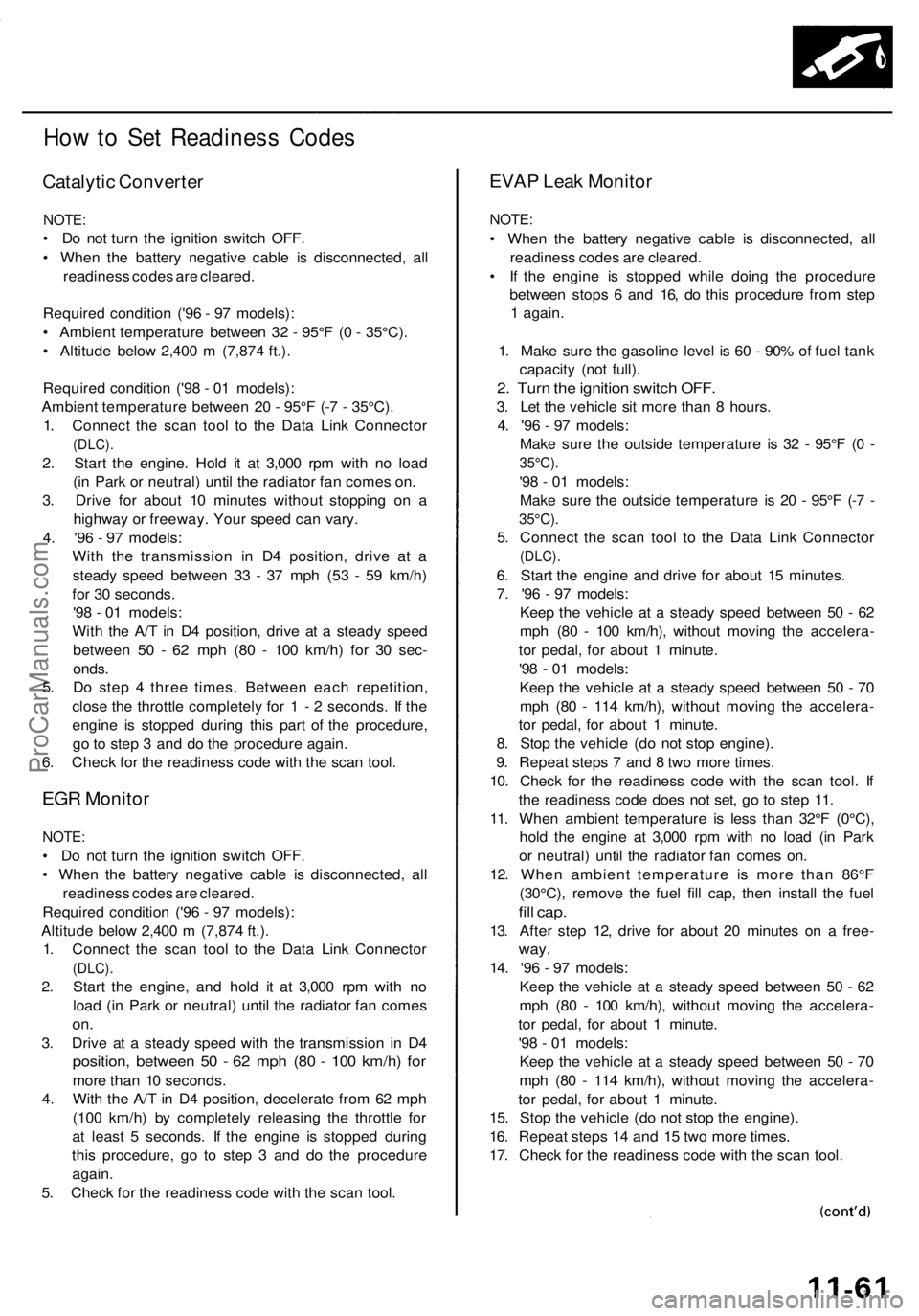
How to Set Readiness Codes
Catalytic Converter
NOTE:
• Do not turn the ignition switch OFF.
• When the battery negative cable is disconnected, all
readiness codes are cleared.
Required condition ('96 - 97 models):
• Ambient temperature between 32 - 95°F (0 - 35°C).
• Altitude below 2,400 m (7,874 ft.).
Required condition ('98 - 01 models):
Ambient temperature between 20 - 95°F (-7 - 35°C).
1. Connect the scan tool to the Data Link Connector
(DLC).
2. Start the engine. Hold it at 3,000 rpm with no load
(in Park or neutral) until the radiator fan comes on.
3. Drive for about 10 minutes without stopping on a
highway or freeway. Your speed can vary.
4. '96 - 97 models:
With the transmission in D4 position, drive at a
steady speed between 33 - 37 mph (53 - 59 km/h)
for 30 seconds.
'98 - 01 models:
With the A/T in D4 position, drive at a steady speed
between 50 - 62 mph (80 - 100 km/h) for 30 sec-
onds.
5. Do step 4 three times. Between each repetition,
close the throttle completely for 1 - 2 seconds. If the
engine is stopped during this part of the procedure,
go to step 3 and do the procedure again.
6. Check for the readiness code with the scan tool.
EGR Monitor
NOTE:
• Do not turn the ignition switch OFF.
• When the battery negative cable is disconnected, all
readiness codes are cleared.
Required condition ('96 - 97 models):
Altitude below 2,400 m (7,874 ft.).
1. Connect the scan tool to the Data Link Connector
(DLC).
2. Start the engine, and hold it at 3,000 rpm with no
load (in Park or neutral) until the radiator fan comes
on.
3. Drive at a steady speed with the transmission in D4
position, between 50 - 62 mph (80 - 100 km/h) for
more than 10 seconds.
4. With the A/T in D4 position, decelerate from 62 mph
(100 km/h) by completely releasing the throttle for
at least 5 seconds. If the engine is stopped during
this procedure, go to step 3 and do the procedure
again.
5. Check for the readiness code with the scan tool.
EVAP Leak Monitor
NOTE:
• When the battery negative cable is disconnected, all
readiness codes are cleared.
• If the engine is stopped while doing the procedure
between stops 6 and 16, do this procedure from step
1 again.
1. Make sure the gasoline level is 60 - 90% of fuel tank
capacity (not full).
2. Turn the ignition switch OFF.
3. Let the vehicle sit more than 8 hours.
4. '96 - 97 models:
Make sure the outside temperature is 32 - 95°F (0 -
35°C).
'98 - 01 models:
Make sure the outside temperature is 20 - 95°F (-7 -
35°C).
5. Connect the scan tool to the Data Link Connector
(DLC).
6. Start the engine and drive for about 15 minutes.
7. '96 - 97 models:
Keep the vehicle at a steady speed between 50 - 62
mph (80 - 100 km/h), without moving the accelera-
tor pedal, for about 1 minute.
'98 - 01 models:
Keep the vehicle at a steady speed between 50 - 70
mph (80 - 114 km/h), without moving the accelera-
tor pedal, for about 1 minute.
8. Stop the vehicle (do not stop engine).
9. Repeat steps 7 and 8 two more times.
10. Check for the readiness code with the scan tool. If
the readiness code does not set, go to step 11.
11. When ambient temperature is less than 32°F (0°C),
hold the engine at 3,000 rpm with no load (in Park
or neutral) until the radiator fan comes on.
12. When ambient temperature is more than 86°F
(30°C), remove the fuel fill cap, then install the fuel
fill cap.
13. After step 12, drive for about 20 minutes on a free-
way.
14. '96 - 97 models:
Keep the vehicle at a steady speed between 50 - 62
mph (80 - 100 km/h), without moving the accelera-
tor pedal, for about 1 minute.
'98 - 01 models:
Keep the vehicle at a steady speed between 50 - 70
mph (80 - 114 km/h), without moving the accelera-
tor pedal, for about 1 minute.
15. Stop the vehicle (do not stop the engine).
16. Repeat steps 14 and 15 two more times.
17. Check for the readiness code with the scan tool.ProCarManuals.com
Page 561 of 1954
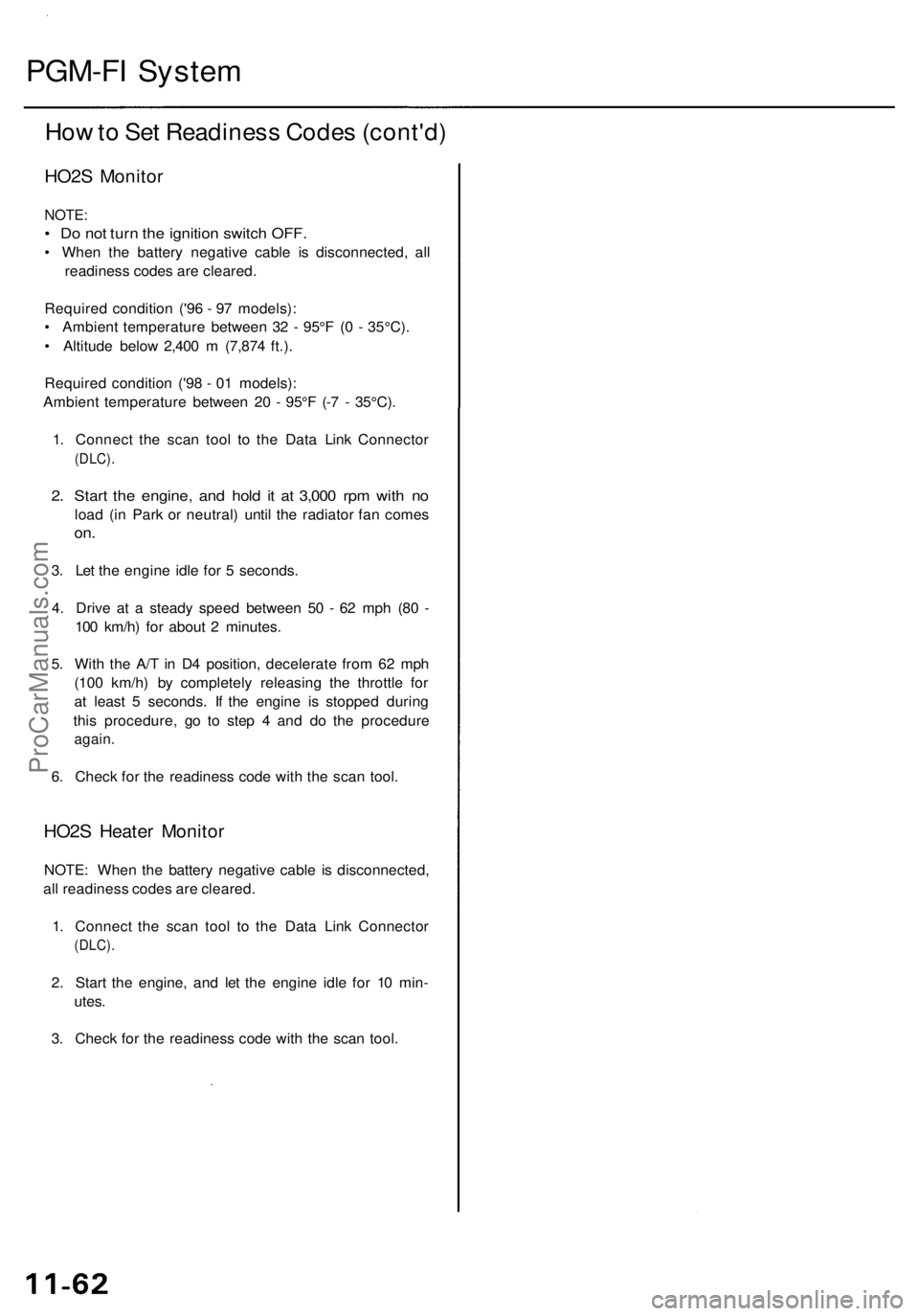
PGM-FI System
How to Set Readiness Codes (cont'd)
HO2S Monitor
NOTE:
• Do not turn the ignition switch OFF.
• When the battery negative cable is disconnected, all
readiness codes are cleared.
Required condition ('96 - 97 models):
• Ambient temperature between 32 - 95°F (0 - 35°C).
• Altitude below 2,400 m (7,874 ft.).
Required condition ('98 - 01 models):
Ambient temperature between 20 - 95°F (-7 - 35°C).
1. Connect the scan tool to the Data Link Connector
(DLC).
2. Start the engine, and hold it at 3,000 rpm with no
load (in Park or neutral) until the radiator fan comes
on.
3. Let the engine idle for 5 seconds.
4. Drive at a steady speed between 50 - 62 mph (80 -
100 km/h) for about 2 minutes.
5. With the A/T in D4 position, decelerate from 62 mph
(100 km/h) by completely releasing the throttle for
at least 5 seconds. If the engine is stopped during
this procedure, go to step 4 and do the procedure
again.
6. Check for the readiness code with the scan tool.
HO2S Heater Monitor
NOTE: When the battery negative cable is disconnected,
all readiness codes are cleared.
1. Connect the scan tool to the Data Link Connector
(DLC).
2. Start the engine, and let the engine idle for 10 min-
utes.
3. Check for the readiness code with the scan tool.ProCarManuals.com
Page 562 of 1954
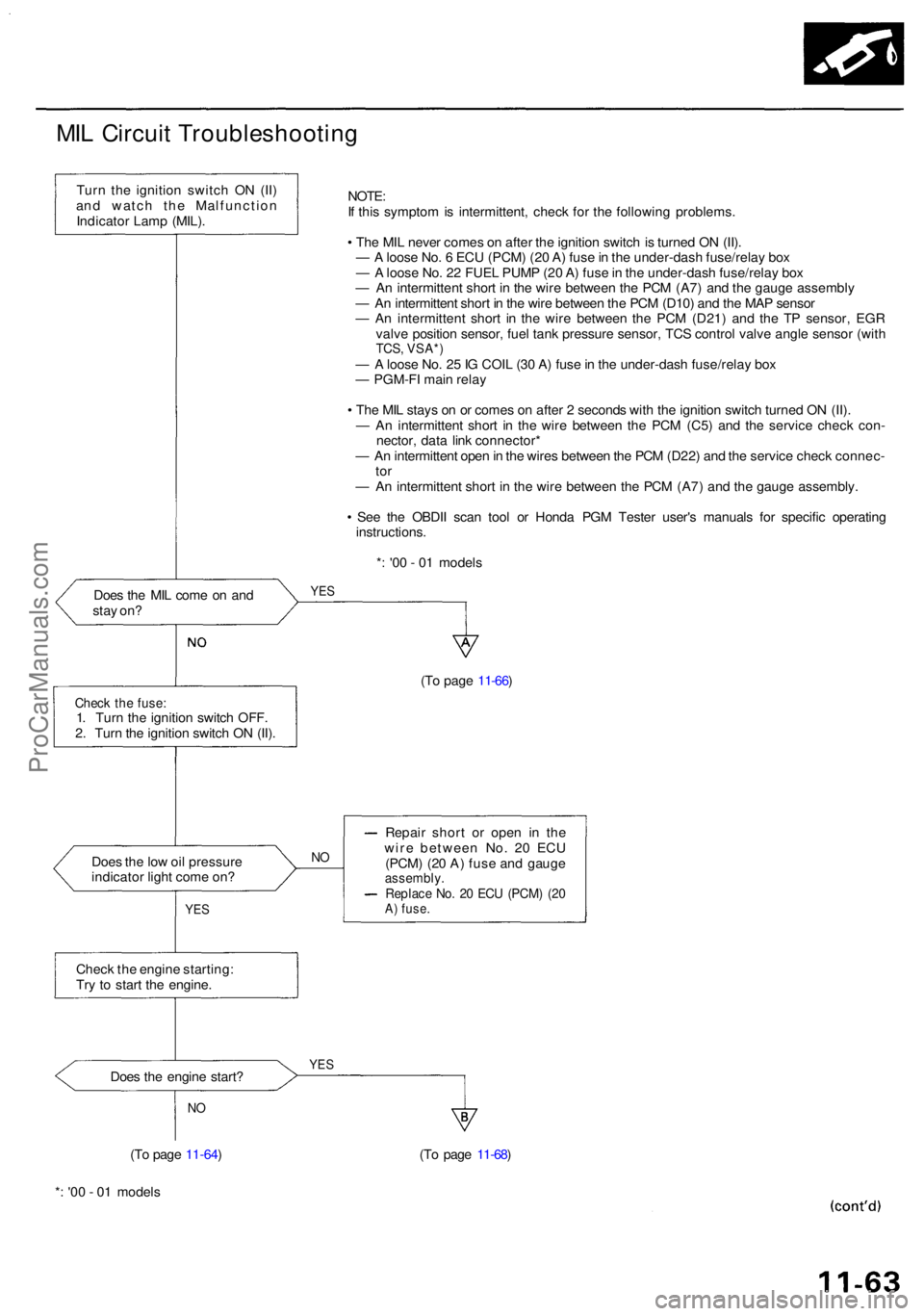
MIL Circui t Troubleshootin g
Turn th e ignitio n switc h O N (II )
an d watc h th e Malfunctio n
Indicato r Lam p (MIL) . NOTE
:
I f thi s sympto m is intermittent , chec k fo r th e followin g problems .
• Th e MI L neve r come s o n afte r th e ignitio n switc h is turne d O N (II) .
— A loos e No . 6 EC U (PCM ) (2 0 A ) fus e in th e under-das h fuse/rela y bo x
— A loos e No . 2 2 FUE L PUM P (2 0 A ) fus e in th e under-das h fuse/rela y bo x
— A n intermitten t shor t i n th e wir e betwee n th e PC M (A7 ) an d th e gaug e assembl y
— A n intermitten t shor t i n th e wir e betwee n th e PC M (D10 ) an d th e MA P senso r
— A n intermitten t shor t i n th e wir e betwee n th e PC M (D21 ) an d th e T P sensor , EG R
valv e positio n sensor , fue l tan k pressur e sensor , TC S contro l valv e angl e senso r (wit h
TCS , VSA* )— A loos e No . 2 5 IG COI L (3 0 A ) fus e in th e under-das h fuse/rela y bo x
— PGM-F I mai n rela y
• Th e MI L stay s o n o r come s o n afte r 2 second s wit h th e ignitio n switc h turne d O N (II) .
— A n intermitten t shor t i n th e wir e betwee n th e PC M (C5 ) an d th e servic e chec k con -
nector , dat a lin k connector *
— A n intermitten t ope n in th e wire s betwee n th e PC M (D22 ) an d th e servic e chec k connec -
tor— A n intermitten t shor t i n th e wir e betwee n th e PC M (A7 ) an d th e gaug e assembly .
• Se e th e OBDI I sca n too l o r Hond a PG M Teste r user' s manual s fo r specifi c operatin g
instructions .
Doe s th e MI L com e o n an d
sta y on ?
YE S
(To pag e 11-66 )
Doe s th e lo w oi l pressur e
indicato r ligh t com e on ?
NO
YE S
Repai r shor t o r ope n i n th e
wir e betwee n No . 2 0 EC U
(PCM ) (2 0 A ) fus e an d gaug e
assembly .Replace No . 2 0 EC U (PCM ) (2 0A) fuse .
Check th e engin e starting :
Tr y t o star t th e engine .
Doe s th e engin e start ?
YES
(To pag e 11-68 )
* : '0 0 - 0 1 model s
(T
o pag e 11-64 )
NO
Chec k th e fuse :1. Tur n th e ignitio n switc h OFF .
2 . Tur n th e ignitio n switc h O N (II) . *
: '0 0 - 0 1 model s
ProCarManuals.com
Page 568 of 1954
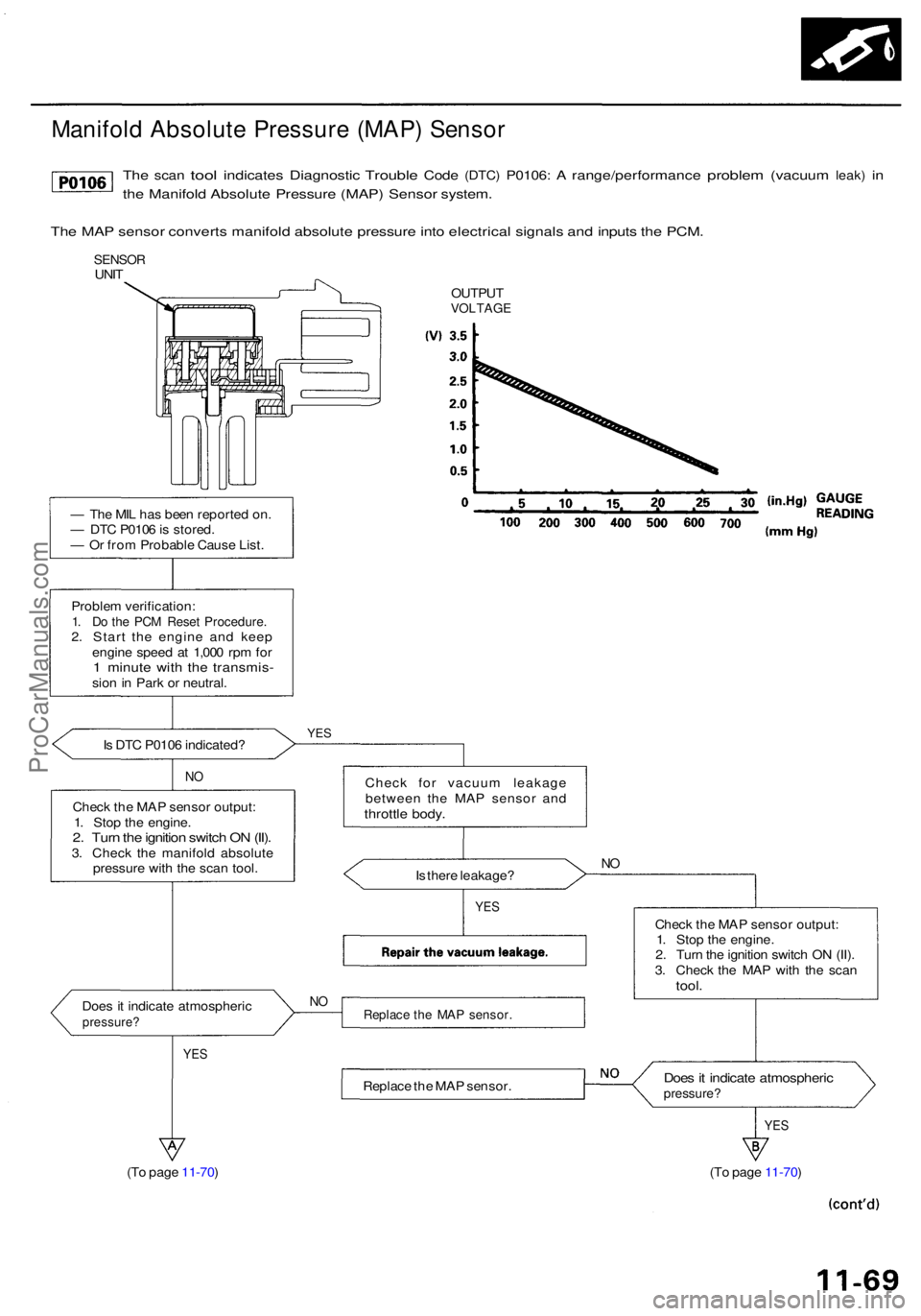
Manifold Absolut e Pressur e (MAP ) Senso r
The sca n tool indicate s Diagnosti c Trouble Code (DTC ) P0106 : A range/performanc e problem (vacuu m leak) in
th e Manifol d Absolut e Pressur e (MAP ) Senso r system .
The MA P senso r convert s manifol d absolut e pressur e int o electrica l signal s an d input s th e PCM .
SENSO RUNIT
— Th e MI L ha s bee n reporte d on .
— DT C P010 6 is stored .
— O r fro m Probabl e Caus e List .
Proble m verification :
1. D o th e PC M Rese t Procedure .2. Star t th e engin e an d kee p
engin e spee d a t 1,00 0 rp m fo r
1 minut e wit h th e transmis -sion in Par k o r neutral .
I s DT C P010 6 indicated ?
NO
Chec k th e MA P senso r output :
1 . Sto p th e engine .
2. Tur n th e ignitio n switc h O N (II) .3. Chec k th e manifol d absolut e
pressur e wit h th e sca n tool .
Doe s i t indicat e atmospheri c
pressure?
YES
(To pag e 11-70 ) OUTPU
T
VOLTAG E
YES
Chec k fo r vacuu m leakag e
betwee n th e MA P senso r an d
throttl e body .
Is ther e leakage ?NO
Replac e th e MA P sensor .
Check th e MA P senso r output :
1 . Sto p th e engine .
2 . Tur n th e ignitio n switc h O N (II) .
3 . Chec k th e MA P wit h th e sca n
tool.
Replac e th e MA P sensor .Does it indicat e atmospheri cpressure?
YES
(To pag e 11-70 )
YES
NO
ProCarManuals.com